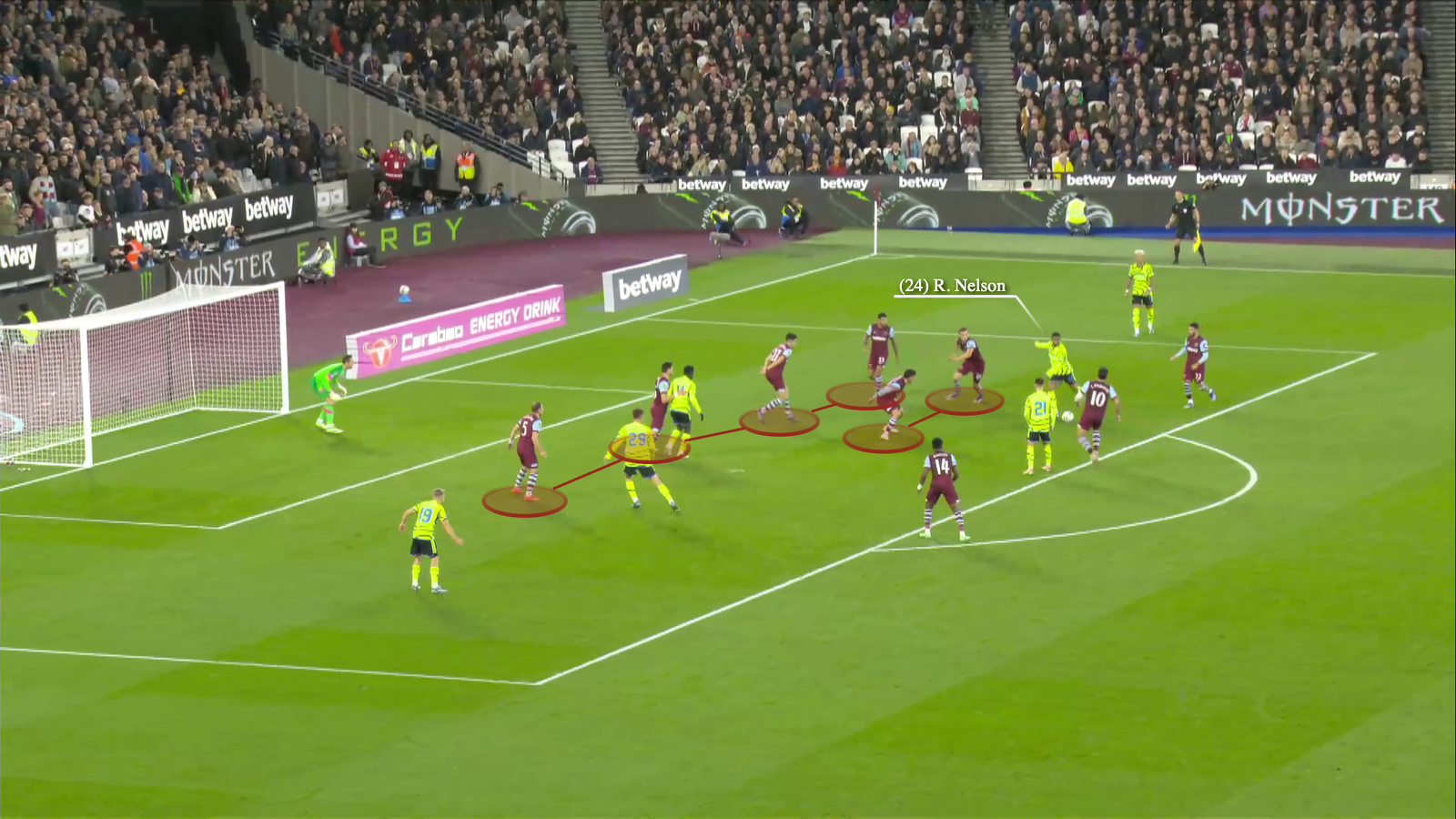West Ham’s win at Arsenal in December was a “You could not script it!” sort of game — except you absolutely could script it.
Arsenal had 77 touches in West Ham’s box, the most by a team without scoring in a Premier League game since Opta started collecting that metric in 2008-09. West Ham manager David Moyes described it as a “brilliant defensive job”, praising their “terrific structural organisation (and) discipline.” Then came the retort: “It’s a big part of football, defending, and sometimes you (the media) don’t want to talk too much about it.”
David, we’re talking about it.
Moyes in December, celebrating his first ever Premier League win away at Arsenal (Catherine Ivill/Getty Images)
That was West Ham’s fourth league win of the season against a ‘Big Six’ opponent, in only their sixth such game. Factor in the domestic cups and they have five wins from eight, having knocked out Arsenal in the Carabao Cup third round at the start of November.
West Ham vs ‘Big Six’, 2023-24
| Opponent | Competition | Result |
|---|---|---|
|
Premier League |
3-1 win |
|
|
Premier League |
3-1 loss |
|
|
Premier League |
3-1 loss |
|
|
League Cup |
3-1 win |
|
|
Premier League |
2-1 win |
|
|
League Cup |
5-1 loss |
|
|
Premier League |
2-0 win |
|
|
Premier League |
2-0 win |
West Ham are tied with Aston Villa for points (12) and wins (four) against ‘Big Six’ sides this season. Since 2018-19, only five clubs have had more such wins in a single season: six for Leicester City, in 2020-21, Brighton & Hove Albion and Brentford, both in 2022-23, and five for Everton and Villa, both in 2020-21.
There is a Mandela effect surrounding West Ham in big games, largely owing to 2015-16, their final season at Upton Park. Slaven Bilic was the manager then, and Dimitri Payet their creative hub. West Ham had seven league wins against the ‘Big Six’, most memorably the final ever game at their old home — a 3-2 comeback win over Manchester United. The ‘Big Six’ all had poor seasons overall that year — Arsenal finished second on 71 points as Leicester won the league.
But since moving to the London Stadium for the 2016-17 season, West Ham have struggled against the domestic elite, losing eight of 12 ‘Big Six’ games in each of the past four seasons. Their only win in 2022-23 was 1-0 at home to Manchester United in the penultimate home game, owing to a David de Gea goalkeeping mistake. That means 2023-24 is already their best points return from these major matchups, despite selling captain Declan Rice to Arsenal in the summer and still having half their games against the ‘Big Six’ left. It is an under-rated kind of success.

They set the tone with a 3-1 win against Chelsea in their first opening game on August 20 — just 25 per cent possession, but 5-3 for shots on target. That game looks anomalous because of Nayef Aguerd’s red card, but it is not. West Ham account for four of the lowest possession shares in Premier League wins this season. In addition to that Chelsea win, 22.3 per cent away to Brighton & Hove Albion (1-3), 25.5 per cent away to Tottenham Hotspur (1-2), 26.8 per cent away to Arsenal (0-2).
More important than possession is possessions — defined as one or more consecutive attacking sequences by the same team. Against ‘Big Six’ opposition, despite having so little of the ball (and less than most other teams) West Ham have faced the second-fewest possessions this season, after Brighton. They defend for long spells, keeping the game settled to prevent transitions, minimising space and encouraging opponents to play expansively. This leaves ample space to counter-attack.
They regain shape quickly if they lose the ball or their high press is broken. Here, away to Tottenham, Mohammed Kudus leads the press and Jarrod Bowen steps aggressively to Ben Davies, trying to lock him out wide.
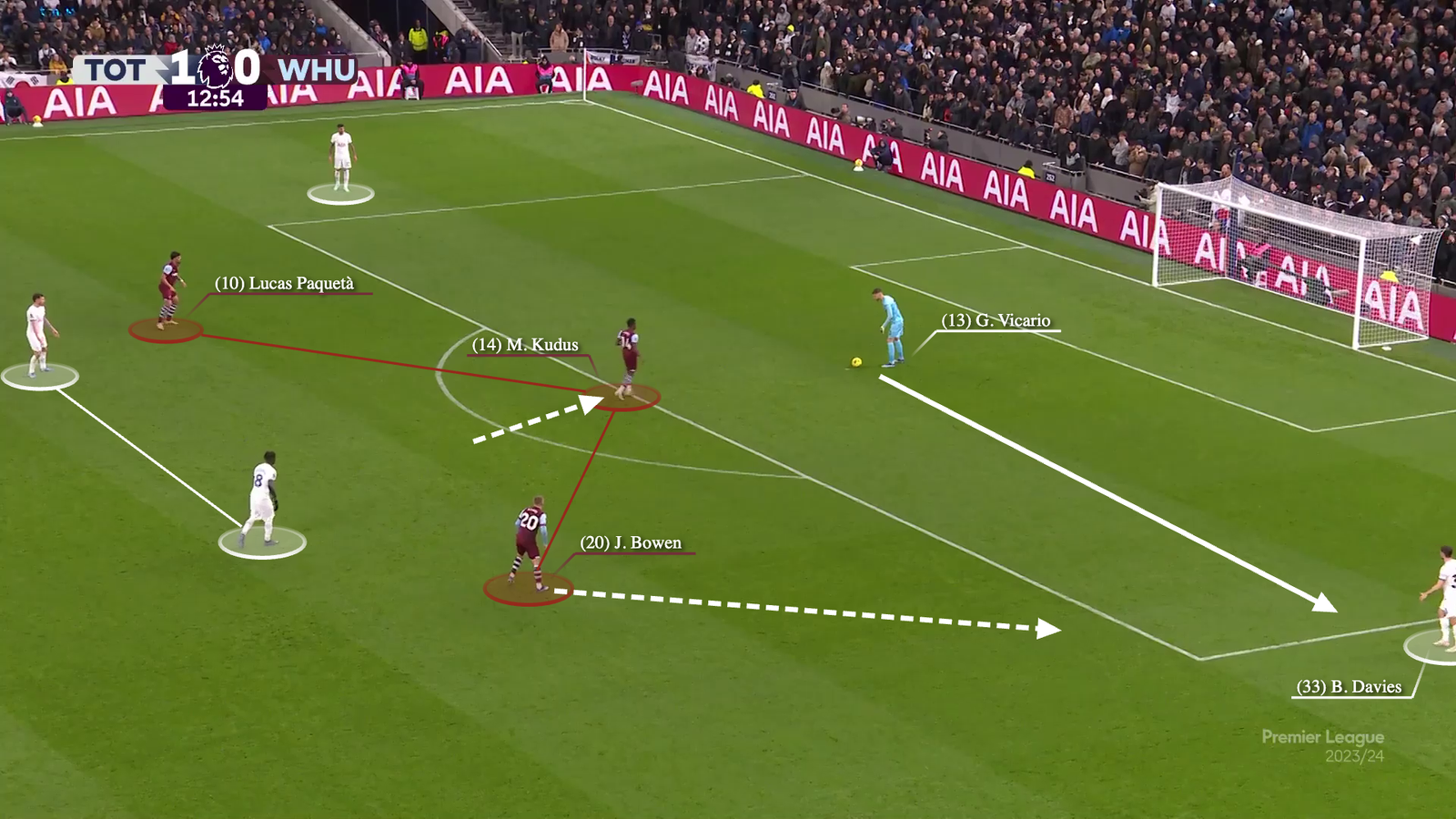
Spurs recycle to goalkeeper Guglielmo Vicario and split the press by playing into Pierre-Emile Hojbjerg and then out wide to Davies.
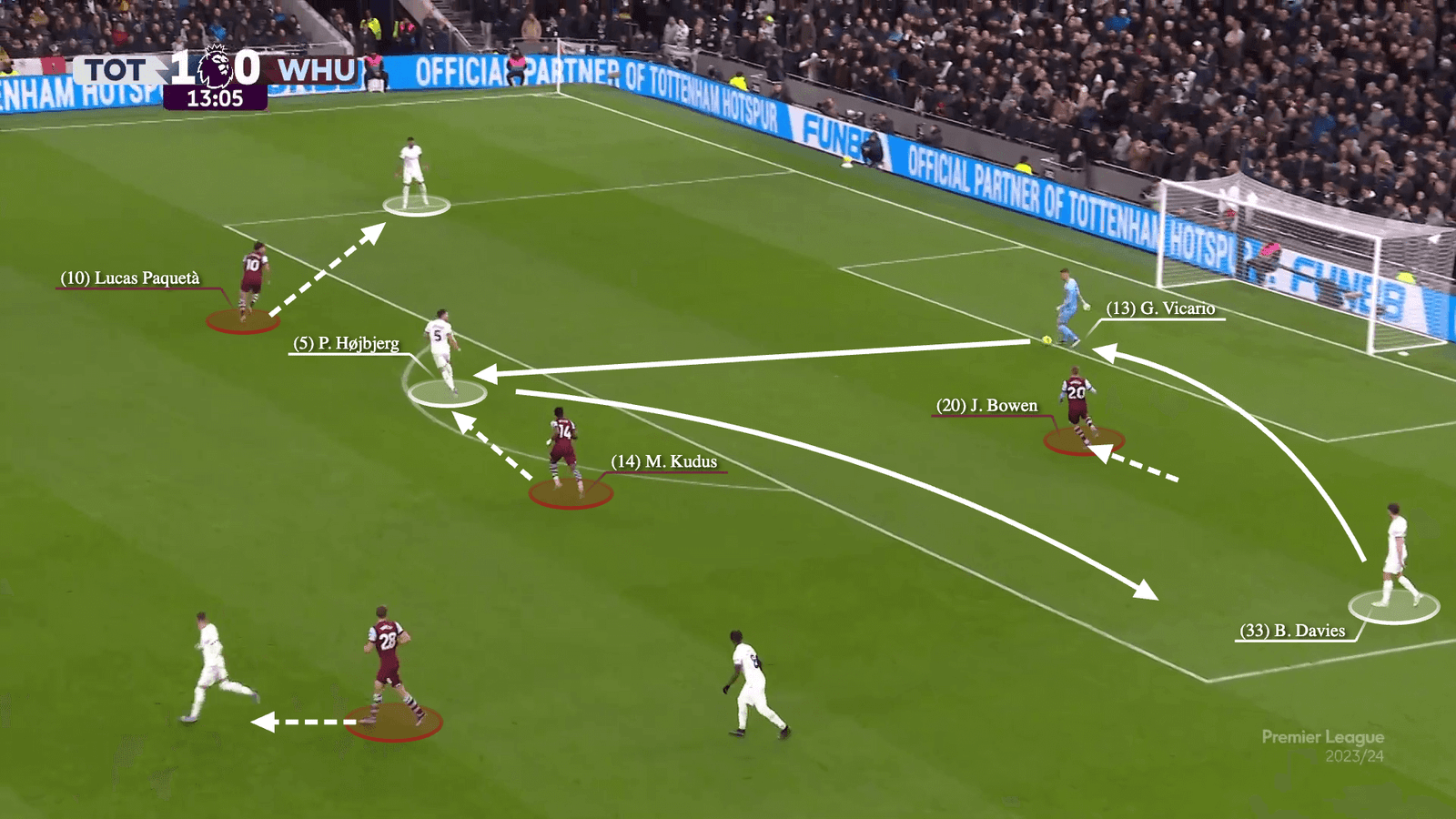
He gives it to Yves Bissouma, who finds Destiny Udogie in space. Look how stretched West Ham are:

Just 12 seconds later though, they have everyone back behind the ball, in a 4-3-3. When Bissouma passes wide to Dejan Kulusevski, Emerson gets out quickly and tackles him.

Defending in their own half, they keep the back four out of the penalty area for as long as possible, often just in front of the 18-yard line. This condenses space, and when opponents find crossing positions, they drop in numbers into the 18-yard box and double up out wide.
For example, at home to Arsenal in that cup match. Mikel Arteta’s side, like many ‘Big Six’ sides, play a withdrawn No 9 and move the full-backs inside, a benefit for West Ham as it causes fewer problems in defending the wings (compared to an overlapping full-back) and a lesser threat attacking crosses.
Oleksandr Zinchenko, a left-back moved infield, shows this. Kudus and Vladimir Coufal shuffle across when he passes wide, going two-v-one against Leandro Trossard. Central midfielders drop in, so West Ham have five-v-three in the box.
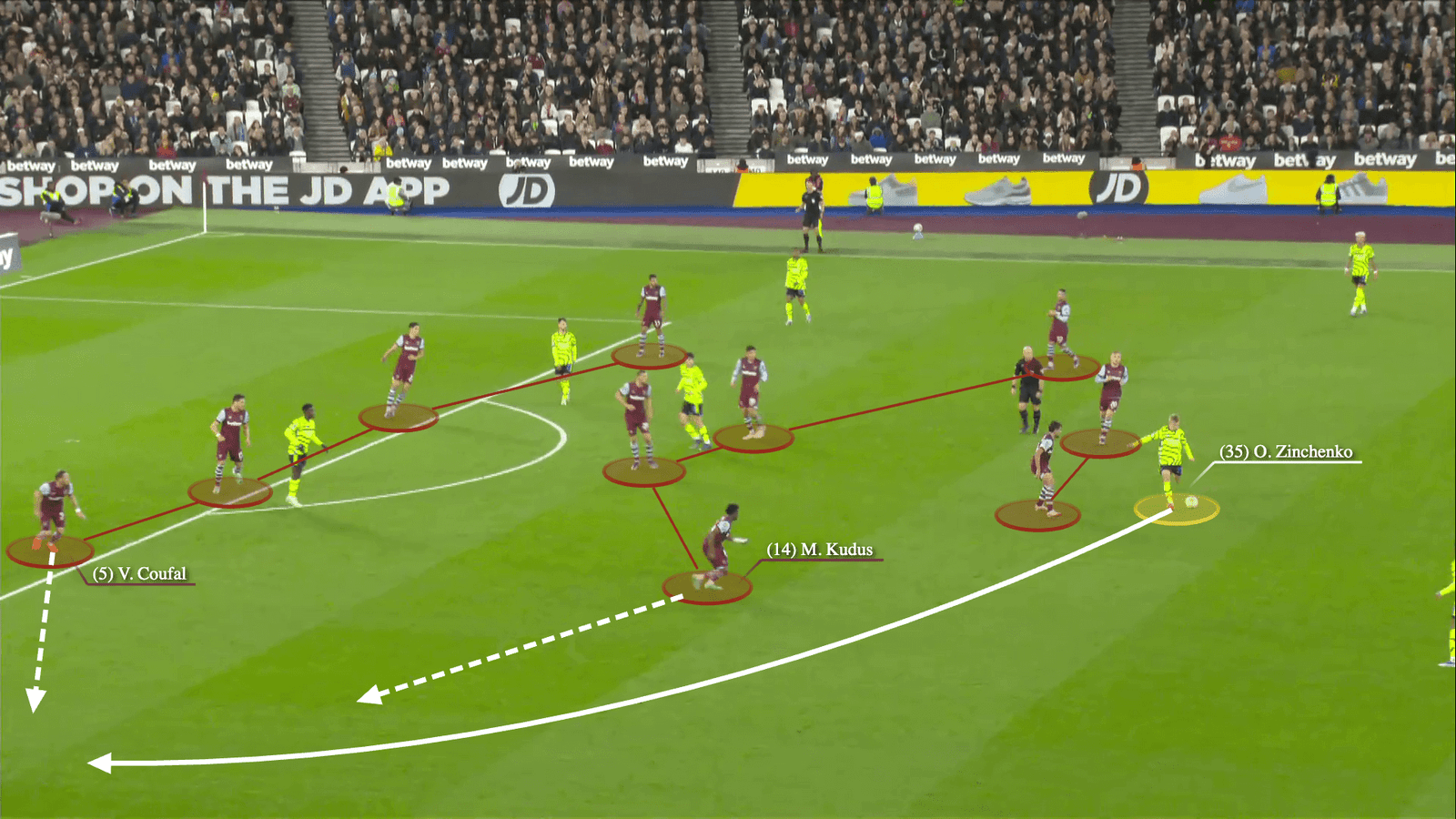
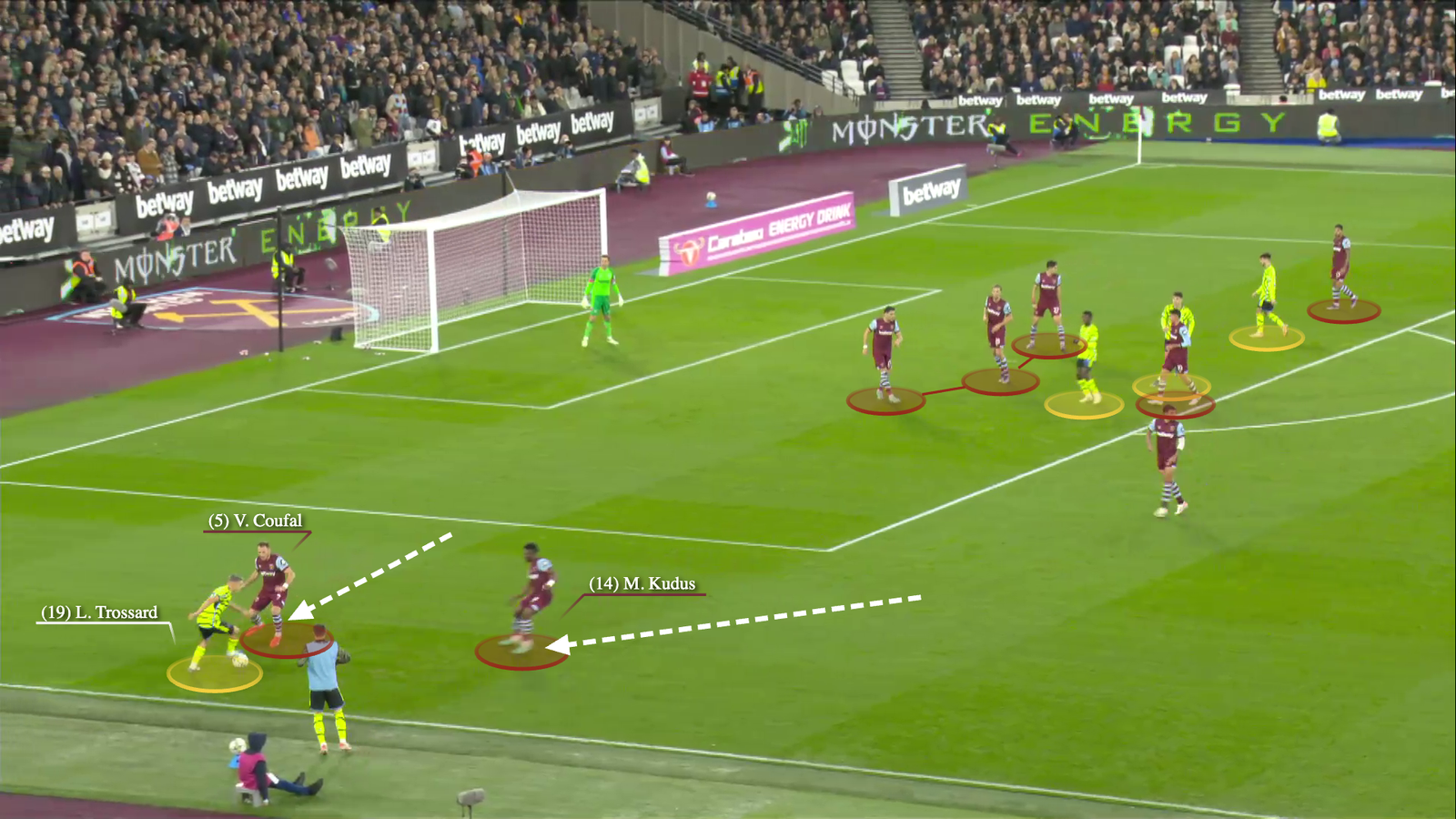
Arsenal recycle, playing left-to-right around the box. Right-winger Reiss Nelson finds a small opening to cut inside, but is met with six claret-and-blue shirts between him and the goal. His shot is blocked.
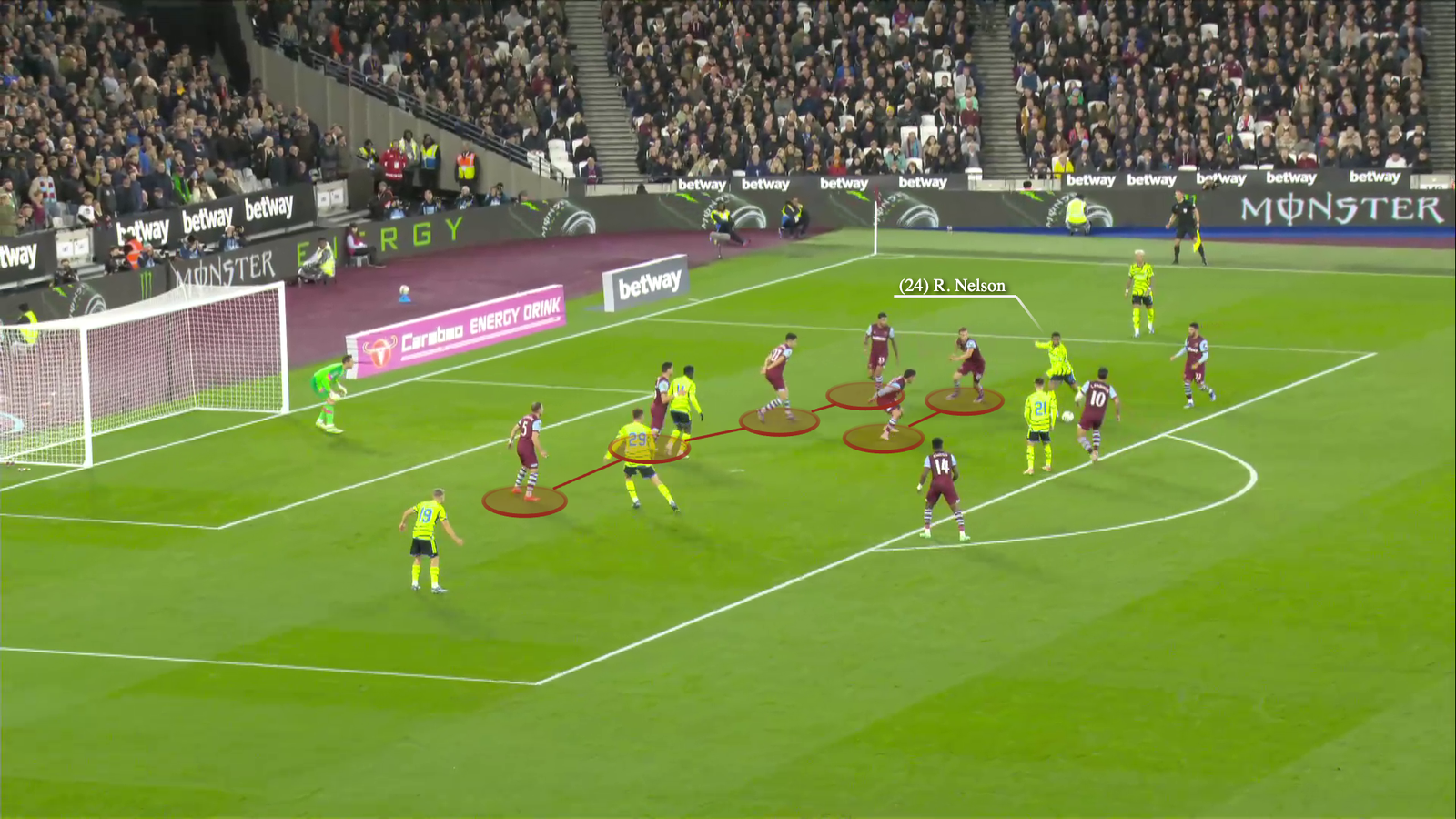
West Ham do not counter-attack on every regain. Especially when they are winning, they will immediately go wide, push the full-backs on and move the wingers inside. This stretches play, allowing them to circulate the ball, take the sting out of the opposition’s momentum, and give their defenders a breather.
Defensive midfielder Edson Alvarez drops either beside or between the centre-backs. This adds security if they lose possession and lets the centre-backs split wider. They connect with their full-back and winger, effective because ‘Big Six’ teams usually defend in 4-4-2 mid-blocks, so they can escape on the outside of the front two.
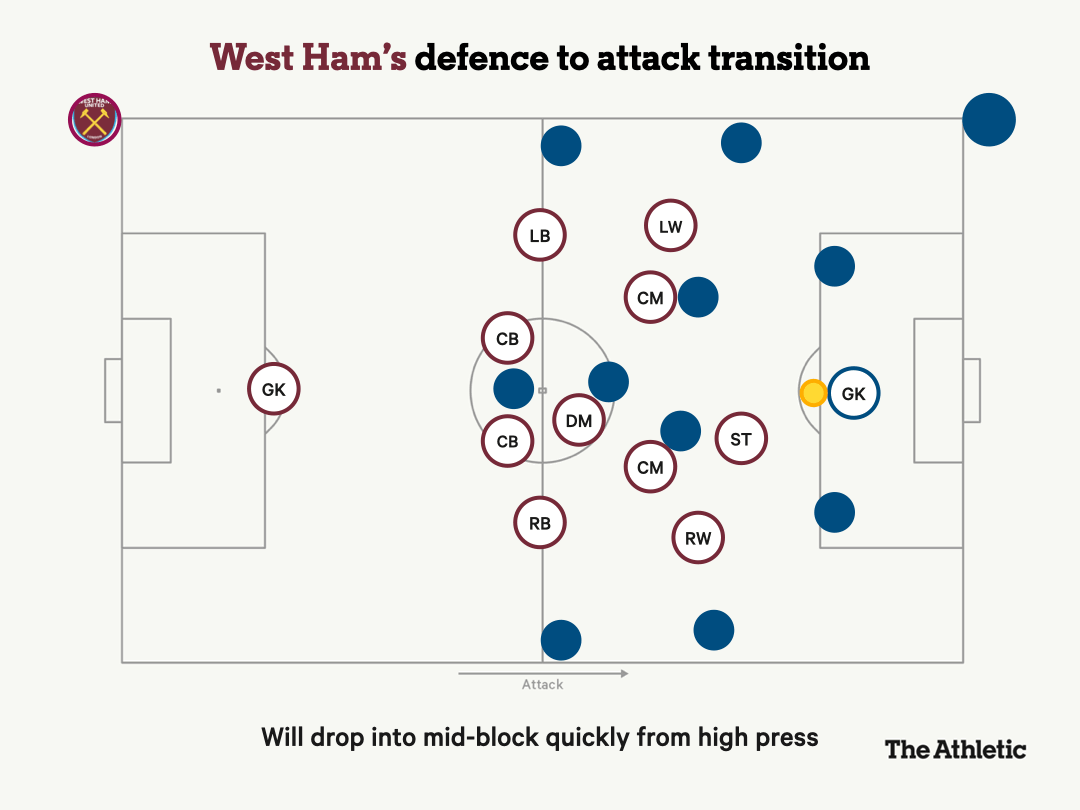
Here, in their first attack away to Arsenal on December 28, Alvarez slots in between the centre-backs. West Ham build down the right, with Coufal pushing on and Kudus rolling inside.
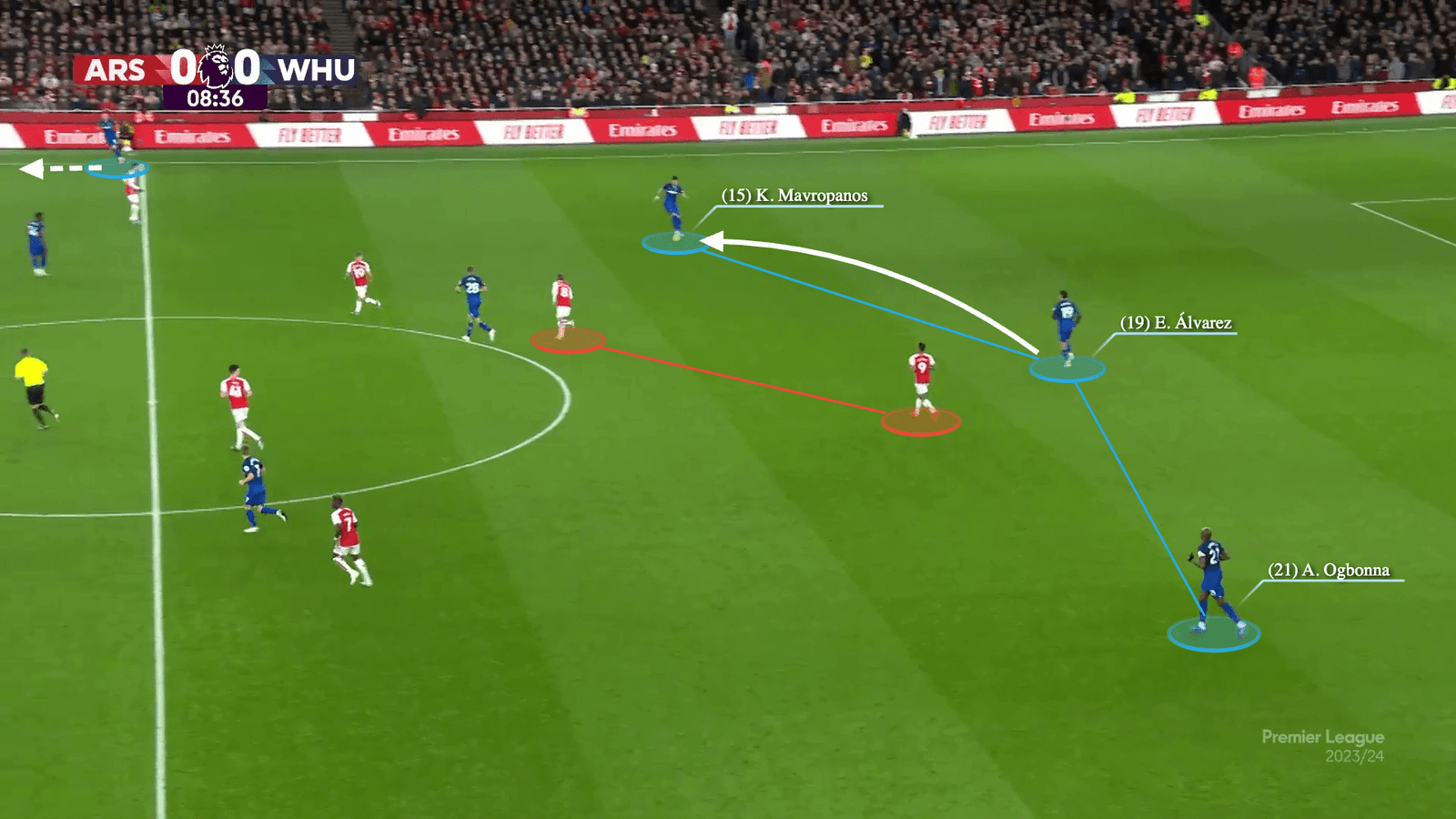
Konstantinos Mavropanos receives outside of Arsenal’s front two. He punches a pass through midfield to Kudus, who flicks it on to Coufal. The full-back is fouled by Zinchenko and West Ham have a free kick in the final third.

When they break, West Ham exploit the wings for two reasons. One, opponents are weak there, often leaving space when moving full-backs inside. Two, West Ham are strong there.
In Bowen, Lucas Paqueta and Kudus, they have versatile attackers. Their ability to interchange positions, dribble and create for each other adds unpredictability, especially compared to Michail Antonio as No 9. He is excellent one-v-two, able to pin and spin a centre-back and bring team-mates into play, but operates in a fixed role.
West Ham now have more outlets, meaning they can hit any of the front three early and let them dribble. Bowen, Kudus and Paqueta are their top three for chance-creating carries in the league (defined as dribbles of at least five metres ending in a key pass or shot).
Their flying full-backs help here, too. Moyes praised “the ability to make passes and play people in behind” on counter-attacks, which they showed with Coufal for the opening goal at home to Manchester City in September.
Jeremy Doku miscontrols Rodri’s chipped pass and the ball drops to Coufal, who immediately plays forward to Bowen, then overlaps, where he’s released by Bowen with a through ball that nutmegs left-back Josko Gvardiol.

Coufal dribbles, and with a two-v-two in the box, crosses to the back-post. James Ward-Prowse duly opens the scoring with a diving header.

There was a similar full-back release pattern for West Ham’s opener away to Arsenal: following a regain in his own half, Kudus dribbled, then Bowen switched play to Emerson down the left. His cross was put behind and they scored from the resulting corner. Likewise, their third goal at home to Arsenal in the Carabao Cup, a Bowen finish from outside the box, came about after a deep regain, a Kudus dribble and Coufal being released on the overlap to cross.
Against ‘Big Six’ opponents this season, just 22 per cent of West Ham’s attacking-half touches have been in the middle channel of the pitch. Only Luton Town (21.3 per cent of touches centrally) have a higher share of their touches in wide areas.
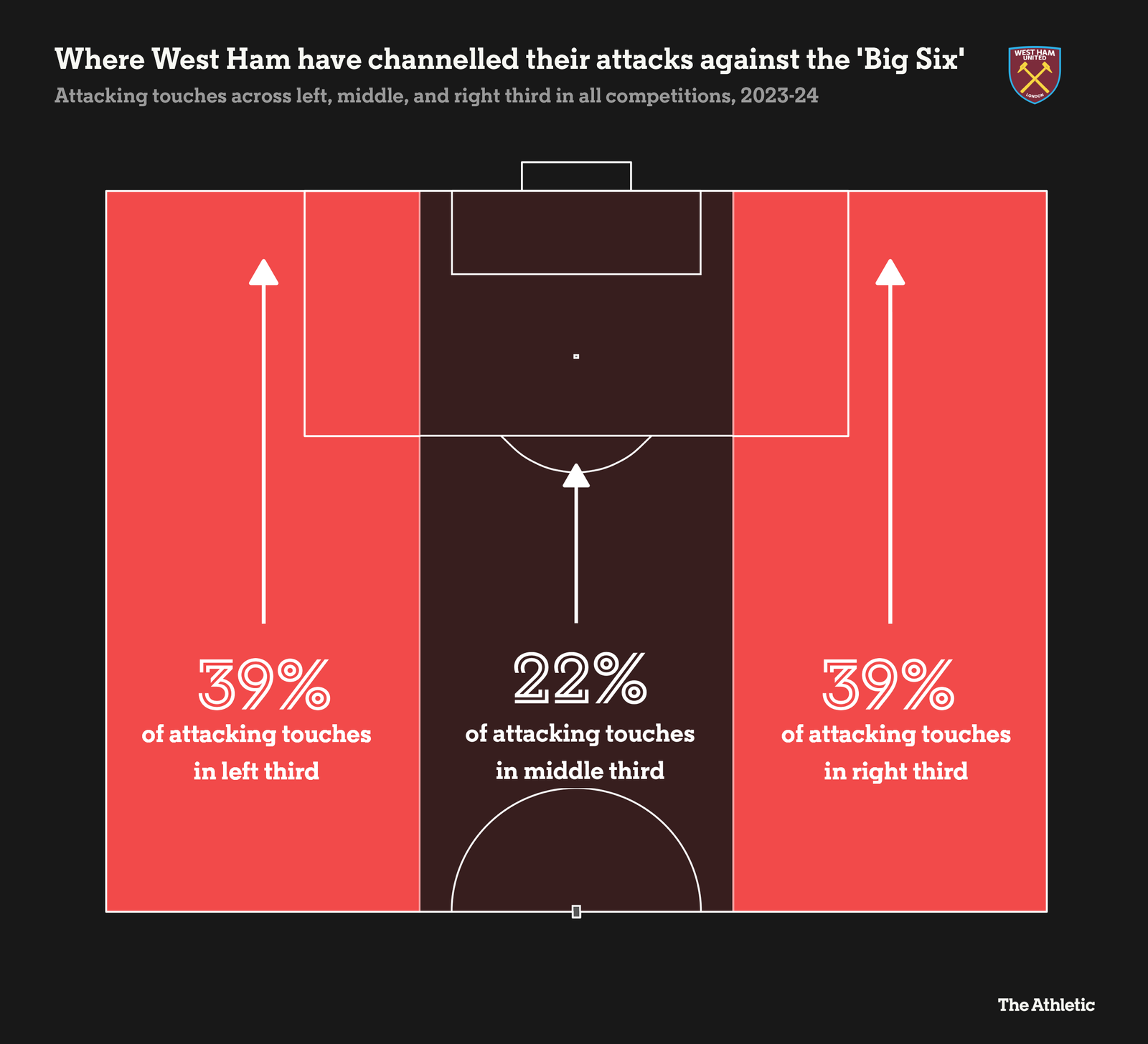
West Ham’s ‘Big Six’ game plan is not tactically flawless — it largely relies on scoring first and not conceding. Last season in such matches, when the opponents got the opening goal eight times, they lost five and drew three, and they were also beaten in three of the four games they scored first in.
Moyes has praised his players’ “toughness and resilience” this season, but West Ham’s success owes more to the technical quality of their recent signings than psychology: goalkeeper Alphonse Areola (on loan in 2021-22 before signing permanently that summer), Paqueta, Kudus, Alvarez (Rice’s replacement) and Ward-Prowse. Moyes has said that their recruitment policy is more ‘win-now’ than it is at Brighton and Brentford, who buy younger players to develop.
Areola has played six of their eight games against ‘Big Six’ sides in all competitions this season, with Lukasz Fabianski in goal for the other two. Collectively, their saves have prevented over three (non-penalty) goals more than the average goalkeeper would be expected to concede, based on xG. That value is close to four if you factor in Areola’s penalty save from Enzo Fernandez, at 1-1 in the home win over Chelsea.
West Ham’s goalkeeping performances this season are the best in the league against the ‘Big Six’.
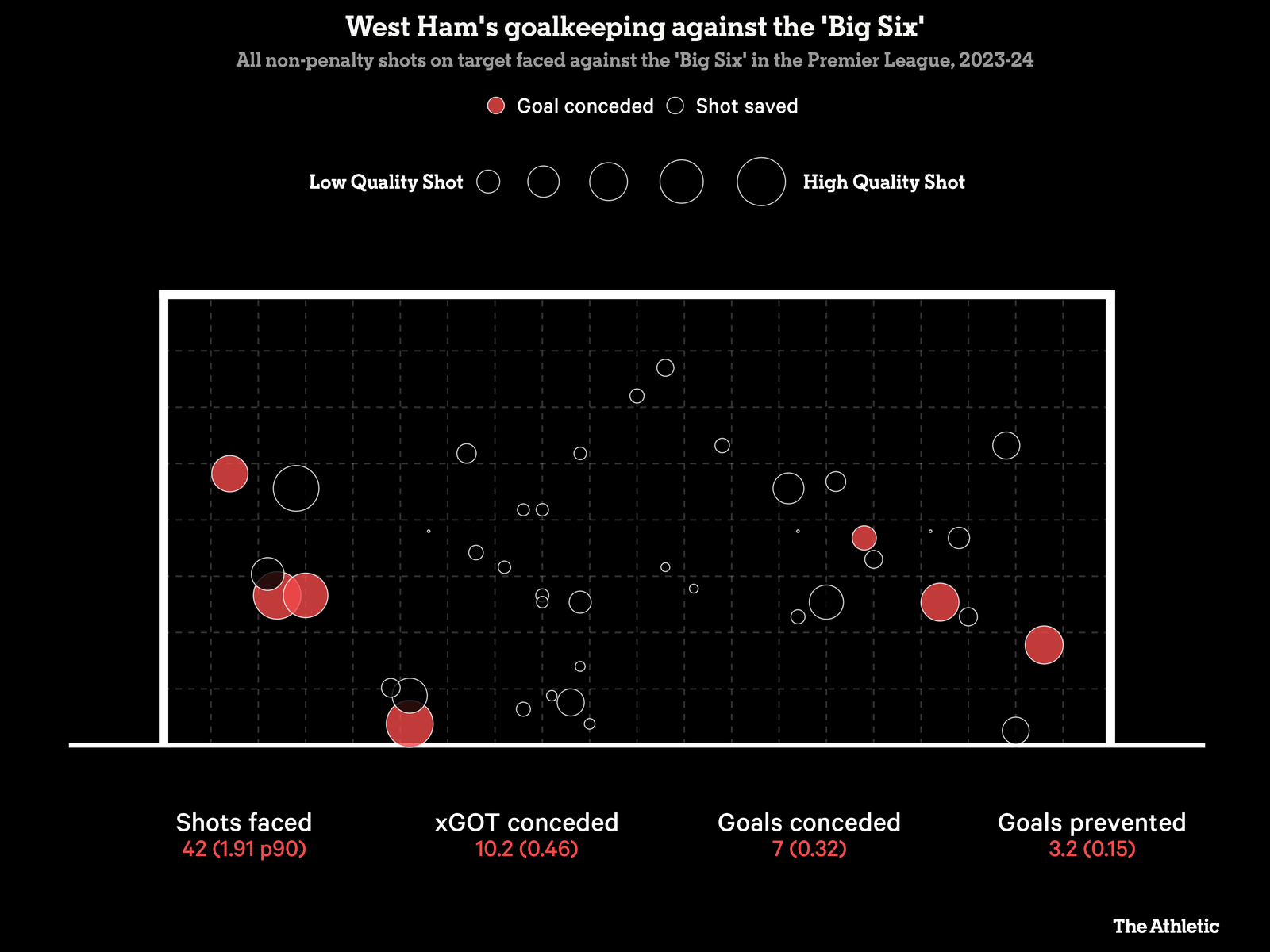
Their 45.8 per cent tackle rate (from 118 tackles) is also the highest by any team against ‘Big Six’ opposition since the start of 2018-19. Having the “terrific structural organisation” that Moyes speaks of is only one part. A tactically-sound game plan still needs to be executed well.
Similarly, 14 goals scored from 9.5 expected goals (all competitions) is a clinical return. Sustainable? Probably not on a 38-game season basis, but games against the ‘Big Six’ only account for around one-third of their league matches.
To beat better opponents you have to play above your level — they punished mistakes by Manchester United and Spurs. That is a skill.
Ward-Prowse’s set-piece threat is the perfect example, with assists from corners for Aguerd against Chelsea and Mavropanos against Arsenal. Those scenarios are big levellers against better teams that have to be maximised.
West Ham’s last win was away to Arsenal in late December — their form since has been patchy. A lacklustre 1-1 draw at home to Bournemouth on Thursday means they are winless in five games, their longest run of the season. That run includes being knocked out of the FA Cup in a third-round replay by Bristol City, who are in the bottom half of the Championship following their Friday night loss to Leeds United.
David Moyes ENDS his run of never winning away at Man Utd, Chelsea, Liverpool & Arsenal in the PL, recording his first ever onion (win)
🍅🍅🍅🥦🍅🍅🍅🍅🥦🥦🥦🍅🍅🍅🍅🥦🍅🍅🥦🍅🥦🥦🥦🍅🍅🍅🍅🥦🍅🥦🥦🍅🥦🥦🍅🍅🍅🍅🍅🥦🍅🥦🥦🍅🍅🍅🥦🍅🍅🍅🍅🍅🥦🍅🍅🍅🥦🍅🍅🍅🍅🍅🍅🍅🍅🍅🍅🍅🍅🍅🧅 https://t.co/Dq8aFUin5l
— Duncan Alexander (@oilysailor) December 28, 2023
It is their second winless streak of at least four games, but they won three in a row twice early on, four consecutively in November and won four out of five in the space of 14 days in December.
Moyes has translated his risk-averse, knockout brand of football that has worked well in European competitions — Europa League semi-finalists in 2021-22, Europa Conference League winners last season, into the Europa League round of 16 this time having topped the group — into their Premier League fixtures.
A trip to Old Trafford tomorrow (Sunday) and the visit of Arsenal a week later might be just what West Ham need right now.
His team winning both those games is a script you could definitely see Moyes writing.
Read the full article here


